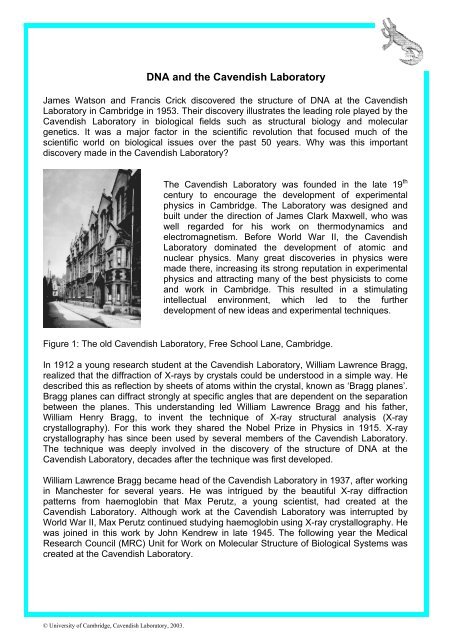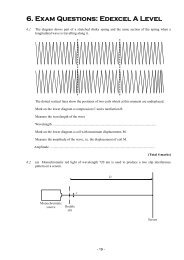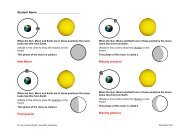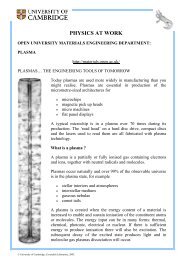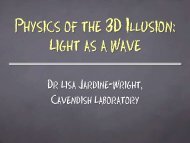DNA and the Cavendish Laboratory - University of Cambridge
DNA and the Cavendish Laboratory - University of Cambridge
DNA and the Cavendish Laboratory - University of Cambridge
Create successful ePaper yourself
Turn your PDF publications into a flip-book with our unique Google optimized e-Paper software.
<strong>DNA</strong> <strong>and</strong> <strong>the</strong> <strong>Cavendish</strong> <strong>Laboratory</strong>James Watson <strong>and</strong> Francis Crick discovered <strong>the</strong> structure <strong>of</strong> <strong>DNA</strong> at <strong>the</strong> <strong>Cavendish</strong><strong>Laboratory</strong> in <strong>Cambridge</strong> in 1953. Their discovery illustrates <strong>the</strong> leading role played by <strong>the</strong><strong>Cavendish</strong> <strong>Laboratory</strong> in biological fields such as structural biology <strong>and</strong> moleculargenetics. It was a major factor in <strong>the</strong> scientific revolution that focused much <strong>of</strong> <strong>the</strong>scientific world on biological issues over <strong>the</strong> past 50 years. Why was this importantdiscovery made in <strong>the</strong> <strong>Cavendish</strong> <strong>Laboratory</strong>?The <strong>Cavendish</strong> <strong>Laboratory</strong> was founded in <strong>the</strong> late 19 thcentury to encourage <strong>the</strong> development <strong>of</strong> experimentalphysics in <strong>Cambridge</strong>. The <strong>Laboratory</strong> was designed <strong>and</strong>built under <strong>the</strong> direction <strong>of</strong> James Clark Maxwell, who waswell regarded for his work on <strong>the</strong>rmodynamics <strong>and</strong>electromagnetism. Before World War II, <strong>the</strong> <strong>Cavendish</strong><strong>Laboratory</strong> dominated <strong>the</strong> development <strong>of</strong> atomic <strong>and</strong>nuclear physics. Many great discoveries in physics weremade <strong>the</strong>re, increasing its strong reputation in experimentalphysics <strong>and</strong> attracting many <strong>of</strong> <strong>the</strong> best physicists to come<strong>and</strong> work in <strong>Cambridge</strong>. This resulted in a stimulatingintellectual environment, which led to <strong>the</strong> fur<strong>the</strong>rdevelopment <strong>of</strong> new ideas <strong>and</strong> experimental techniques.Figure 1: The old <strong>Cavendish</strong> <strong>Laboratory</strong>, Free School Lane, <strong>Cambridge</strong>.In 1912 a young research student at <strong>the</strong> <strong>Cavendish</strong> <strong>Laboratory</strong>, William Lawrence Bragg,realized that <strong>the</strong> diffraction <strong>of</strong> X-rays by crystals could be understood in a simple way. Hedescribed this as reflection by sheets <strong>of</strong> atoms within <strong>the</strong> crystal, known as ‘Bragg planes’.Bragg planes can diffract strongly at specific angles that are dependent on <strong>the</strong> separationbetween <strong>the</strong> planes. This underst<strong>and</strong>ing led William Lawrence Bragg <strong>and</strong> his fa<strong>the</strong>r,William Henry Bragg, to invent <strong>the</strong> technique <strong>of</strong> X-ray structural analysis (X-raycrystallography). For this work <strong>the</strong>y shared <strong>the</strong> Nobel Prize in Physics in 1915. X-raycrystallography has since been used by several members <strong>of</strong> <strong>the</strong> <strong>Cavendish</strong> <strong>Laboratory</strong>.The technique was deeply involved in <strong>the</strong> discovery <strong>of</strong> <strong>the</strong> structure <strong>of</strong> <strong>DNA</strong> at <strong>the</strong><strong>Cavendish</strong> <strong>Laboratory</strong>, decades after <strong>the</strong> technique was first developed.William Lawrence Bragg became head <strong>of</strong> <strong>the</strong> <strong>Cavendish</strong> <strong>Laboratory</strong> in 1937, after workingin Manchester for several years. He was intrigued by <strong>the</strong> beautiful X-ray diffractionpatterns from haemoglobin that Max Perutz, a young scientist, had created at <strong>the</strong><strong>Cavendish</strong> <strong>Laboratory</strong>. Although work at <strong>the</strong> <strong>Cavendish</strong> <strong>Laboratory</strong> was interrupted byWorld War II, Max Perutz continued studying haemoglobin using X-ray crystallography. Hewas joined in this work by John Kendrew in late 1945. The following year <strong>the</strong> MedicalResearch Council (MRC) Unit for Work on Molecular Structure <strong>of</strong> Biological Systems wascreated at <strong>the</strong> <strong>Cavendish</strong> <strong>Laboratory</strong>.© <strong>University</strong> <strong>of</strong> <strong>Cambridge</strong>, <strong>Cavendish</strong> <strong>Laboratory</strong>, 2003.
<strong>DNA</strong> <strong>and</strong> <strong>the</strong> <strong>Cavendish</strong> <strong>Laboratory</strong>In 1949 Francis Crick joined <strong>the</strong> MRC Unit in <strong>the</strong> <strong>Cavendish</strong> <strong>Laboratory</strong>. His job was tocontinue <strong>the</strong> X-ray analysis <strong>of</strong> haemoglobin, but he was always eager to absorb <strong>and</strong>underst<strong>and</strong> new areas <strong>of</strong> science. He liked to discuss ideas, <strong>and</strong> was not afraid <strong>of</strong>speaking his mind. He had a penetrating voice <strong>and</strong> laugh that annoyed William LawrenceBragg, <strong>and</strong> <strong>the</strong>y did not have a good relationship.James Watson came to <strong>the</strong> <strong>Cavendish</strong> <strong>Laboratory</strong> in <strong>the</strong> early autumn <strong>of</strong> 1951 to learnmore about X-ray crystallography <strong>and</strong> its application to biological materials. Francis Crickwelcomed intelligent discussions about structural biology <strong>and</strong> was soon working withJames Watson to try to discover <strong>the</strong> structure <strong>of</strong> <strong>DNA</strong>.James Watson <strong>and</strong> Francis Crick worked toge<strong>the</strong>rvery well because <strong>the</strong>y were interested in <strong>the</strong>same problem, <strong>and</strong> each <strong>of</strong> <strong>the</strong>m had a differentbackground experience <strong>and</strong> area <strong>of</strong> expertise.Although <strong>the</strong>ir early attempts to build models <strong>of</strong><strong>the</strong> structure <strong>of</strong> <strong>DNA</strong> were not successful, <strong>the</strong>ycontinued to pursue <strong>the</strong> problem. Making use <strong>of</strong><strong>the</strong> X-ray diffraction work <strong>of</strong> Maurice Wilkins <strong>and</strong>Rosalind Franklin at King’s College in London,James Watson <strong>and</strong> Francis Crick discovered <strong>the</strong>structure <strong>of</strong> <strong>DNA</strong> in spring 1953.Figure 2: The <strong>DNA</strong> Double HelixA second immensely important discovery was made at <strong>the</strong> <strong>Cavendish</strong> <strong>Laboratory</strong> a fewmonths later in 1953. Max Perutz realized that attaching a single large atom (e.g. Mercury)to a haemoglobin molecule would change <strong>the</strong> X-ray diffraction pattern obtained from <strong>the</strong>crystal, making it possible to completely solve <strong>the</strong> structure <strong>of</strong> haemoglobin. He realizedthat this doping technique could be applied to a wide range <strong>of</strong> complex biologicalmaterials. Experimental techniques had to be developed over several years, organized byMax Perutz <strong>and</strong> John Kendrew, to put Max Perutz’s idea into practice. In 1960 <strong>the</strong> correctstructures <strong>of</strong> both haemoglobin <strong>and</strong> myoglobin discovered. This work led to a massiveexpansion in <strong>the</strong> number <strong>of</strong> people studying <strong>the</strong> structure <strong>of</strong> complex biological materials.Although <strong>the</strong> <strong>Cavendish</strong> <strong>Laboratory</strong> provided <strong>the</strong> simulating environment in which newideas were explored <strong>and</strong> developed, <strong>the</strong> successful discovery <strong>of</strong> <strong>the</strong> structure <strong>of</strong> <strong>DNA</strong> wasalso dependent on fortuitous circumstances <strong>and</strong> <strong>the</strong> personalities <strong>of</strong> <strong>the</strong> people involved.The entire field <strong>of</strong> structural biology can be traced back to <strong>the</strong> development <strong>of</strong> X-raycrystallography by William Lawrence Bragg <strong>and</strong> his fa<strong>the</strong>r William Henry Bragg. Inparticular, <strong>the</strong> insight <strong>of</strong> William Lawrence Bragg that led to <strong>the</strong> development <strong>of</strong> Bragg’sLaw for X-ray diffraction was crucial to <strong>the</strong> continued interest in <strong>the</strong> use <strong>of</strong> X-rays to studymaterials.The discoveries <strong>of</strong> <strong>the</strong> structure <strong>of</strong> <strong>DNA</strong> <strong>and</strong> <strong>the</strong> structures <strong>of</strong> complex biological materialswere recognized in <strong>the</strong> same year (1962) by <strong>the</strong> award <strong>of</strong> a Nobel Prize in Physiology orMedicine to James Watson, Francis Crick <strong>and</strong> Maurice Wilkins, <strong>and</strong> a Nobel Prize inChemistry to Max Perutz <strong>and</strong> John Kendrew. Rosalind Franklin had died <strong>of</strong> cancer in1958. These discoveries are <strong>the</strong> basis <strong>of</strong> many areas <strong>of</strong> modern biology <strong>and</strong> medicine <strong>and</strong>are considered to be amongst <strong>the</strong> most important discoveries made at <strong>the</strong> <strong>Cavendish</strong><strong>Laboratory</strong> since it opened over 100 years ago.© <strong>University</strong> <strong>of</strong> <strong>Cambridge</strong>, <strong>Cavendish</strong> <strong>Laboratory</strong>, 2003.


